

A complete version of The Gospel of Mary Magdalene - National Gnosticism & Heretical Spirituality. Mary Magdalene has perennially intrigued western culture, yet her interest has peaked in the last generation because of the parallel interest in the Gnostic Gospels.
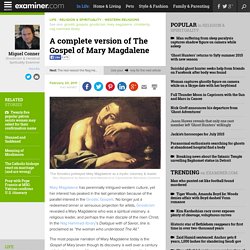
No longer just a redeemed sinner or sensuous projection for artists, Gnosticism revealed a Mary Magdalene who was a spiritual visionary, a religious leader, and perhaps the main disciple of the risen Christ. In the Nag Hammadi library’s Dialogue with of Savior, she is proclaimed as “the woman who understood The All.” The most popular narration of Mary Magdalene today is the Gospel of Mary (even though its discovery is well over a century old). The Murder of Mary Magdalene and the Hidden Encryption in Art. The Murder of Mary Magdalene and the Hidden Encryption in Art by Dan Green The mysterious biblical figure of Mary Magdalene received a high profile boost to the uninitiated courtesy of Dan Brown’s blockbuster ‘The Da Vinci Code’, elevating her status even higher than when in 1969 the Catholic Church decided to pronounce her a Saint – quite an improvement from their previous character assassination that had assured her image for the previous centuries as being that of a harlot.
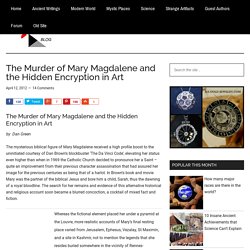
In Brown’s book and movie Mary was the partner of the biblical Jesus and bore him a child, Sarah, thus the dawning of a royal bloodline. The search for her remains and evidence of this alternative historical and religious account soon became a blurred concoction, a cocktail of mixed fact and fiction. Now cast into the role of a Hercule Poirot style forensic detective, I will try to explain how the evidence began to unfold.
Spiritism. Allan Kardec, The Codifier of Spiritism Spiritism is a doctrine codified in the 19th century by the French educator Allan Kardec.
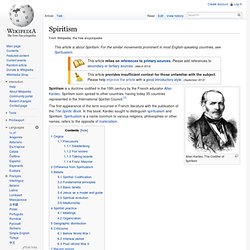
Spiritism soon spread to other countries, having today 35 countries represented in the International Spiritist Council.[1] Origins[edit] Edgar Cayce. Edgar Cayce (/ˈkeɪsiː/; March 18, 1877 – January 3, 1945) was an American psychic who allegedly possessed the ability to answer questions on subjects as varied as healing, reincarnation, wars, Atlantis and future events while in a trance.
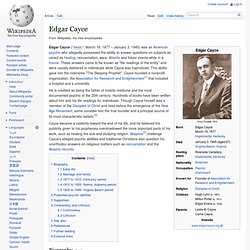
These answers came to be known as "life readings of the entity" and were usually delivered to individuals while Cayce was hypnotized. This ability gave him the nickname "The Sleeping Prophet". Cayce founded a nonprofit organization, the Association for Research and Enlightenment[1] that included a hospital and a university. Cayce became a celebrity toward the end of his life, and he believed the publicity given to his prophecies overshadowed the more important parts of his work, such as healing the sick and studying religion. Christmas Candles. FR.
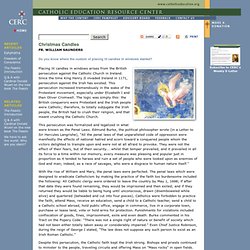
WILLIAM SAUNDERS Placing lit candles in windows arises from the British persecution against the Catholic Church in Ireland. Since the time King Henry II invaded Ireland in 1171, persecution against the Irish has existed. Reincarnation. Reincarnation is the religious or philosophical concept that the soul or spirit, after biological death, begins a new life in a new body that may be human, animal or spiritual depending on the moral quality of the previous life's actions.
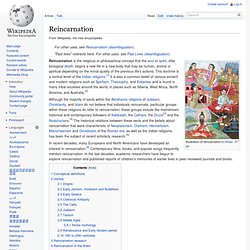
This doctrine is a central tenet of the Indian religions.[1] It is also a common belief of various ancient and modern religions such as Spiritism, Theosophy, and Eckankar and is found in many tribal societies around the world, in places such as Siberia, West Africa, North America, and Australia.[2] In recent decades, many Europeans and North Americans have developed an interest in reincarnation.[6] Contemporary films, books, and popular songs frequently mention reincarnation. In the last decades, academic researchers have begun to explore reincarnation and published reports of children's memories of earlier lives in peer-reviewed journals and books.
Conceptual definitions[edit] Emerald Tablet. An imaginative 17th century depiction of the Emerald Tablet from the work of Heinrich Khunrath, 1606.

The Emerald Tablet, also known as the Smaragdine Table, or Tabula Smaragdina, is a compact and cryptic piece of Hermetica reputed to contain the secret of the prima materia and its transmutation. It was highly regarded by European alchemists as the foundation of their art and its Hermetic tradition. The original source of the Emerald Tablet is unknown. Chinese alchemy. Chinese alchemy is a part of the larger tradition of Taoist body-spirit cultivation that developed from the traditional Chinese understanding of medicine and the body.
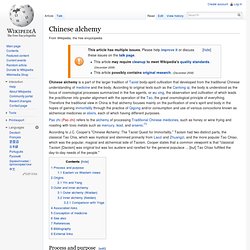
According to original texts such as the Cantong qi, the body is understood as the focus of cosmological processes summarized in the five agents, or wu xing, the observation and cultivation of which leads the practitioner into greater alignment with the operation of the Tao, the great cosmological principle of everything. Therefore the traditional view in China is that alchemy focuses mainly on the purification of one's spirit and body in the hopes of gaining immortality through the practice of Qigong and/or consumption and use of various concoctions known as alchemical medicines or elixirs, each of which having different purposes. According to J.C. Process and purpose[edit] By refining bases into gold, the alchemist believed that immortal life would be delivered if the "fake" or synthetic gold was ingested. The Secret of the Golden Flower. Translations[edit] "Gathering the light" -- an illustration of the first stage of meditation There are significant differences between the Wilhelm and Cleary translations.
Taoist Alchemy: Neidan and Waidan. The Golden Elixir ▶ Taoist Alchemy Fabrizio Pregadio Background.
